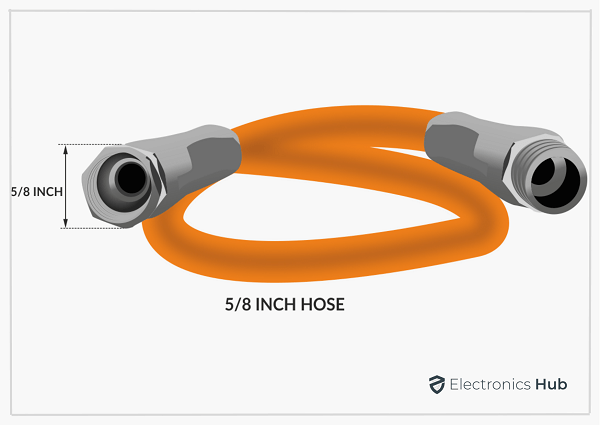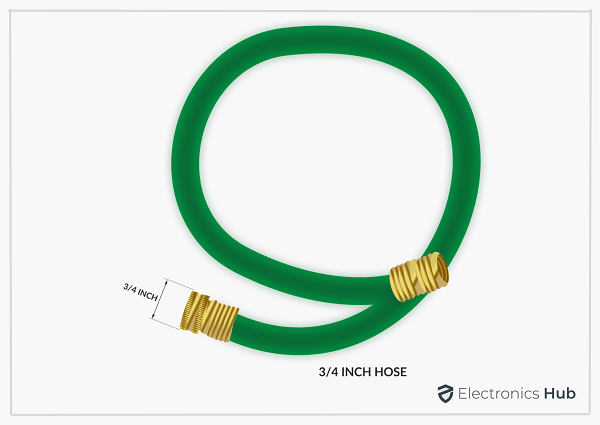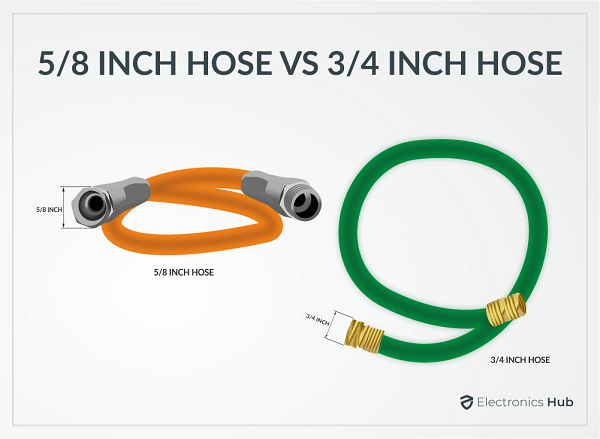A metal garden hose is probably the best product that you can buy for your garden. These hoses are highly durable and offer great performance for their price. You will have to go through a lot of options before you can choose a suitable hose for your garden. There are various specifications like the hose length, overall build quality, and most important of all, the available hose width. A lot of users are often confused between the available options based on the hose width available for the budget range and requirements. Today, we will be taking a thorough look at both of these options and try to conclude the best option for our readers. Even if you are not familiar with these hose types, you can take a brief look at our guide and understand both a ⅝ inch and a ¾ inch hose in detail. You will also be able to choose the proper option once you reach the end of this guide.
5/8-inch Hose
Before we can decide the best hose size for most applications, we need to understand both of these options thoroughly. First, let’s take a look at ⅝ inches hoses and their features. A ⅝ inch water hose is the most commonly available water hose in the market, and you can easily find these hoses in any supermarket or store that offers gardening supplies. The ⅝ inch hoses have nearly ⅝ inches internal diameter, and hence the name. These hoses might be popular in the market, but they are significantly underpowered compared to its competitor. For a constant discharge rate, the ⅝ inches cross-sectional area of these hoses offers an increased water velocity but at the cost of a reduced water pressure rate. For a ⅝ inches water hose which is nearly 25 feet long, you can expect about 44 gallons of water discharge every minute while the input is kept at its peak capacity. While it might look like a lot, it is not compared to what other types of water hose is capable of. The discharge rate of a ⅝ inches hose decreases further with an increase in length. For a 100 feet long ⅝ inch hose, you will be getting nearly 11 gallons of water discharge with the same source. Let’s take a look at some features of a ⅝ inch water hose:
3/4-inch Hose
Now that you are familiar with the ⅝ inch water hose let’s turn our attention to the ¾ inches water hose. Here’s a brief introduction of ¾ inches water hose and some potential advantages that you can get with it. The ¾ inches water hose is basically a special type of water hose that is only available at outlets that specifically provide heavy-duty gardening supplies. As the name suggests, the ¾ inches water hose has a slightly larger ¾ inches inner diameter, which increases its cross-sectional area throughout its length. These pipes are very powerful in terms of fluid discharge and can be used with various types of fluids with a promising performance. For the same discharge compared to a ⅝ inches pipe, a ¾ inches pipe have comparatively higher pressure output but at a reduced velocity. If you compare both hoses, you will find that the overall discharge rate of a ¾ inch water hose is significantly higher than that of a ⅝ inch pipe. At a length of 25 feet, a ¾ inch water hose is capable of delivering up to 72 gallons of water every minute, which is nearly twice as compared to ¾ inches. The same goes for a longer pipe, as a 100 feet long ¾ inch pipe delivers up to 18 gallons of water every minute. Let’s take a look at some features of a ¾ inch water hose:
Best Hose 5/8 vs. 3/4 inch for Different Uses
Both ⅝ and ¾ inch water hoses are suitable for a particular application and cannot be replaced with one another. Hence, you should consider your application first before deciding which water hose you are going to buy. Here, we will discuss some common tasks that require a durable water hose and decide which hose is a better fit for the job.
1. Pressure Washing
Depending upon what you are washing, a 5.8-inch water hose is generally the right choice for such applications. If you are going to pressure wash from a distance, you will require a high velocity of water which is available with the ⅝ inch hose. Also, a ⅝ inch water hose avoids wastage of water as per minute gallon capacity is lower.
2. Maintaining a Lawn or Garden
For compact-sized gardens and lawns, a ⅝ inches water hose is still the right choice. It is easier to move and can easily cover the whole area within a few minutes. Also, it is important to choose a smaller diameter pipe if you require a longer hose as larger pies are very heavy and harder to move.
3. Maintaining a Large Backyard Lawn
The situation gets a bit tricky with large sized backyard or lawns. For such instances, you should probably go with a stationary pipe installation that has multiple sprinklers connected to it. This way, you will not need to manually water the whole area, and you can rely on the high discharge capacity of the hose to get the job done.
4. Miscellaneous Applications
If your job requires you to manually control the hose, it is recommended to get a ⅝ inches water hose. If you are unsure, you can always try either option and get a feel before selecting the right choice for yourself. If you are sure that you can carry a heavy load, you can prefer a ¾ inch water hose.
Differences of 5/8 inch hoses and 3/4 inch hoses
While choosing a water hose, you need to consider many aspects such as length, build quality, brand, price range, pipe width, etc. On top of that, you need to carefully select these specifications so that you get a decent performance from your water hose without any complaints. As for the pipe width, there are only 2 options available that are ⅝ inch and ¾ inch variants. Here’s how they differ in terms of performance.
Conclusion:
After taking a look at both ⅝ inch and ¾ inch water hoses along with their features and possible pros and cons, you must have decided which option you need for yourself. We have also provided a detailed comparison table here so that you can make a choice easily. If you are still not sure which one you need to get, here’s our recommendation. For basic operations like spray washing your car or watering your personal garden, a ⅝ inch water hose is more than capable enough for the job. On top of that, it is easily available in the market at a cheaper price range. Thus, you can get a better option in the same budget compared to a ¾ inch pipe. And if you feel that the pipe is not suitable for your work, you can always get an upgrade later in the future. Comment * Name * Email * Website
Δ








![]()